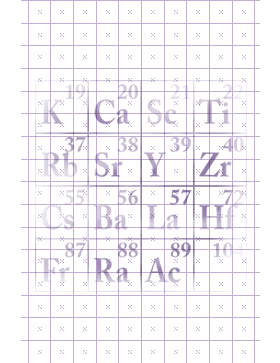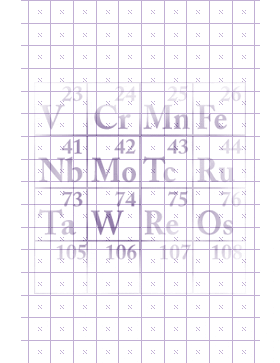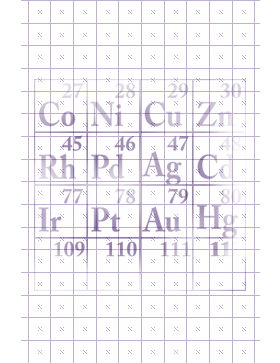 |
About this Interactive
Introduction |
Goals |
How to Use This Site |
Credits

Introduction
The Periodic Table is an interactive Web site where students can learn about the Periodic Table of the Elements: how it is organized (into groups); the atomic structure of each group; characteristics of isotopes; the scientific notation that is used to define atoms and elements; and how the chemical properties of elements are determined by their atomic composition.
Students will explore the basics of the atom and how scientists came to understand its structure, learn how the number of protons in an atom determines what element it is, and discover how elements, which interact to make up all living things and materials in the world, can be organized and understood using the Periodic Table. Students will also learn about atomic structure, including how negatively charged electrons fill the orbitals of atoms and how the placement of electrons affects the chemical nature of elements; students will also learn the notation systems that are used to describe the orbital configuration.
Students will explore the Periodic Table further to learn how it can be divided into groups (the vertical columns of the table) and periods (the horizontal rows); that atoms can come in different types of forms like isotopes; (how to calculate the mass of an atom, and how the properties of those groups and periods vary depending on the structure of each atom. Finally, students will investigate the characteristics of families of elements, such as the halogen family and noble gases.

Goals
According to the National Science Education Standards for the physical sciences (Content Standard B: Physical Science), students in grades 9-12 should develop an understanding of the:
- Structure and function of atoms
- Structure and properties of matter
The fundamental concepts and principles that underlie these standards are listed below.
STRUCTURE OF ATOMS
- Matter is made of minute particles called atoms, and atoms are composed of even smaller components. These components have measurable properties, such as mass and electrical charge. Each atom has a positively charged nucleus surrounded by negatively charged electrons. The electric force between the nucleus and electrons holds the atom together.
- The atom's nucleus is composed of protons and neutrons, which are much more massive than electrons. When an element has atoms that differ in the number of neutrons, these atoms are called different isotopes of the element.
- The nuclear forces that hold the nucleus of an atom together, at nuclear distances, are usually stronger than the electric forces that would make it fly apart. Nuclear reactions convert a fraction of the mass of interacting particles into energy, and they can release much greater amounts of energy than atomic interactions. Fission is the splitting of a large nucleus into smaller pieces. Fusion is the joining of two nuclei at extremely high temperature and pressure, and is the process responsible for the energy of the sun and other stars.
- Radioactive isotopes are unstable and undergo spontaneous nuclear reactions, emitting particles and/or wavelike radiation. The decay of any one nucleus cannot be predicted, but a large group of identical nuclei decay at a predictable rate. This predictability can be used to estimate the age of materials that contain radioactive isotopes.
STRUCTURE AND PROPERTIES OF MATTER
- Atoms interact with one another by transferring or sharing electrons that are furthest from the nucleus. These outer electrons govern the chemical properties of the element.
- An element is composed of a single type of atom. When elements are listed in order according to the number of protons (called the atomic number), repeating patterns of physical and chemical properties identify families of elements with similar properties. This "Periodic Table" is a consequence of the repeating pattern of outermost electrons and their permitted energies.
- Bonds between atoms are created when electrons are paired up by being transferred or shared. A substance composed of a single kind of atom is called an element. The atoms may be bonded together into molecules or crystalline solids. A compound is formed when two or more kinds of atoms bind together chemically.
- The physical properties of compounds reflect the nature of the interactions among its molecules. These interactions are determined by the structure of the molecule, including the constituent atoms and the distances and angles between them.
- Solids, liquids, and gases differ in the distances and angles between molecules or atoms and therefore the energy that binds them together. In solids the structure is nearly rigid; in liquids molecules or atoms move around each other but do not move apart; and in gases molecules or atoms move almost independently of each other and are mostly far apart.
- Carbon atoms can bond to one another in chains, rings, and branching networks to form a variety of structures, including synthetic polymers, oils, and the large molecules essential to life.
Activities that explore these concepts will help students develop the ability to do scientific inquiry and to understand the investigative process. (Content Standard A: Science as Inquiry).
(National Science Education Standards, 1996)
With these standards in mind, the specific goals of The Periodic Table interactive are for students to be able to:
- Understand how our ideas about the atom and its structure progressed, how the Periodic Table developed, and how the Periodic Table gives us a way to visualize and organize the atoms that make up each element.
- Understand the structure of the atom and that it is made up of protons, neutrons, and electrons, as well as the characteristic properties of chemical elements, which are determined by their atomic structure, including their number of protons and the number of energy levels that are filled by electrons.
- Understand that atoms can take different forms (isotopes) based on the number of neutrons they have in their nucleus.
- Understand the concepts of atomic number and atomic mass and be able to calculate an atom's average relative mass.
- Describe the periodicity of the elements and how they can be divided into groups (the alkali metals, alkaline earth metals, noble gases, halogens, nitrogen family elements, carbon family elements, boron family elements, and transition metals, and rare earths), each with different properties based on the number of electrons in their highest energy level.
- Describe how elements can bond together based on these properties to form unique types of materials.

How to Use This Site
The Periodic Table interactive consists of a brief introduction, five sessions, and an assessment. Each session describes various concepts in detail, and is followed by an interactive component that allows students to explore a concept introduced in the session or to evaluate their understanding of the information through an interactive quiz. Students should read each section carefully and then use the interactive to test their knowledge of a concept, such as how to calculate the mass of an atom, how to use the Periodic Table to name elements, and the ways that atoms bond together. Students can go back and review the sessions as needed and run the animations again until they have a thorough understanding of the subject matter.
The Periodic Table interactive can be incorporated into a larger unit on chemistry or physical science. It provides a good introduction to chemistry and the chemical properties of substances, and can be used to offer students a solid understanding of the structure of the natural world.
Technical Requirements
- Browser using Internet Explorer 5 (and higher) and Mozilla 5 (and higher). Best results will be with using latest browser versions
- Flash player 7 minimum requirement
- Javascript in browser is turned on

Credits
Production Credits
Periodic Table is a production of Thirteen/WNET New York. Copyright 2007, Annenberg Media. All rights reserved.
Content Production
Nancy Miller, Writer
Nancy Miller has been a teacher of science and history in New Jersey for the past 27 years. She is a past County Teacher of the Year, National Teacher Training Institute Master Teacher of the Year, Tandy Teacher Scholar awardee for excellence in the Teaching of Math, Science and Technology, Woodrow Wilson Fellowship Teacher Scholar, and a member of the Women in Science Professional delegation to the People's Republic of China. She has been the president of the New Jersey Science Teachers Association during the 2006-2007 school year.
Her interests include astronomy, weather prediction, and travel. She will be chasing tornadoes on the Great Plains this spring as she completes her Master of GeoSciences degree from Mississippi State University.
Leslie Kriesel, Lisa Weinberger, Copy Editors
Interactive and Broadband Unit
Anthony Chapman, Director of Interactive and Broadband
Dave Hirmes, Producer
Shannon Palmer, Flash Animator and Programmer
Lenny Drozner, Designer and Flash Animator
Ying Zhou-Hudson, Graphics Production
Brian Santalone, HTML Implementation
|


 |
 |
 |
 |
|


